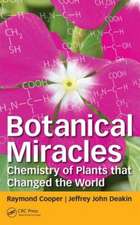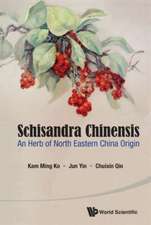Duke's Handbook of Medicinal Plants of Latin America
Autor James A. Dukeen Limba Engleză Hardback – 24 oct 2008
A Comprehensive Guide Addressing Safety, Efficacy, and Suitability
About a quarter of all the medicines we use come from rainforest plants and more than 1,400 varieties of tropical plants are being investigated as potential cures for cancer. Curare comes from a tropical vine and quinine from the cinchona tree. A comprehensive guide to safety, efficacy, and suitability, Duke’s Handbook of Medicinal Plants of Latin America responds to continuing interest in medicinal plants and the potential remedies they contain.
Determine Which Species Can Be Used for Specific Targets
The author of Green Pharmacy Herbal Handbook and CRC Handbook of Medicinal Herbs, James A. Duke covers roughly 500 of the more important Native Latin American medicinal plants in a highly organized format. After a brief introduction, each entry contains scientific and colloquial names, synonyms, reference to illustrations, notes, biological activities, medicinal indications, dosages, potential hazards, extracts, and references. This format supplies a starting point for determining which species can be used for specific targets.
Better Data Helps You Focus Your Search
Year-round moderate temperatures, abundant rainfall, and rich soils make tropical Latin America home to nearly 100,000 of the world’s 300,000 known species of plants, and therefore home to untold numbers of potential cures. Focusing on 500 of the most well-known and well-studied plants, this book helps you focus your search for ammunition against constantly evolving pathogens and newly emerging diseases.
Preț: 1233.66 lei
Preț vechi: 1682.10 lei
-27% Nou
Puncte Express: 1850
Preț estimativ în valută:
236.06€ • 246.97$ • 196.10£
236.06€ • 246.97$ • 196.10£
Carte tipărită la comandă
Livrare economică 03-17 aprilie
Preluare comenzi: 021 569.72.76
Specificații
ISBN-13: 9781420043167
ISBN-10: 1420043161
Pagini: 960
Ilustrații: 99 b/w images and 43 color images
Dimensiuni: 178 x 254 x 48 mm
Greutate: 1.79 kg
Ediția:1
Editura: CRC Press
Colecția CRC Press
Locul publicării:Boca Raton, United States
ISBN-10: 1420043161
Pagini: 960
Ilustrații: 99 b/w images and 43 color images
Dimensiuni: 178 x 254 x 48 mm
Greutate: 1.79 kg
Ediția:1
Editura: CRC Press
Colecția CRC Press
Locul publicării:Boca Raton, United States
Public țintă
ProfessionalRecenzii
"This publication is a great reference and a starting point for those interested in the medicinal uses of Latin American plants, with particular emphasis on their safety and efficacy. The price of the book is reasonable, considering the extensive sources of information, and the number of species covered."
—Hector Rodolfo Juliani, Rutgers University, in Economic Botany, No: 64(1), 2010, pp. 83
"James A. Duke is one of the world’s most recognized leading authors on the subject of medicinal herbs. This is a valuable reference book, well organized and written in an easily understandable, user friendly format."
—In Making Scents, Winter/ Spring 2009, Vol. 13, No. 2
"Any one working on the medicinal plants of Latin America and wanting to gain an insight into what research has been undertaken on a particular species will find this book essential reading. As with all the books produced by James Duke it is informative and provides a wealth of basic information. ... The power of this book is in the electronic version where the data are searchable, and it is easy to link many of the references to their sources such as PubMed. For each of the 500 species the authors provide its accepted Latin bionomial scientific name, authority, family synonyms and common names, along with a code that relates to the safety of the species relative to coffee."
—Monique S. J. Simmonds writing in Expl Agric.,2010, volume 46 (1)
—Hector Rodolfo Juliani, Rutgers University, in Economic Botany, No: 64(1), 2010, pp. 83
"James A. Duke is one of the world’s most recognized leading authors on the subject of medicinal herbs. This is a valuable reference book, well organized and written in an easily understandable, user friendly format."
—In Making Scents, Winter/ Spring 2009, Vol. 13, No. 2
"Any one working on the medicinal plants of Latin America and wanting to gain an insight into what research has been undertaken on a particular species will find this book essential reading. As with all the books produced by James Duke it is informative and provides a wealth of basic information. ... The power of this book is in the electronic version where the data are searchable, and it is easy to link many of the references to their sources such as PubMed. For each of the 500 species the authors provide its accepted Latin bionomial scientific name, authority, family synonyms and common names, along with a code that relates to the safety of the species relative to coffee."
—Monique S. J. Simmonds writing in Expl Agric.,2010, volume 46 (1)
Cuprins
Acknowledgments Senior Author’s Introduction The Author Bibliographic Abbreviations (books and journals frequently consulted) Chemical/Medical Abbreviations Geographic/Linguistic Abbreviations Format of this Book Alphabetical listing of Plants
Descriere
The greatest diversity of plants in the world occurs in tropical Latin America, which is home to nearly 100,000 of the world’s 300,000 known species. Despite this diversity, Latin American flora remains the least investigated. Providing complete coverage of nearly 500 of the most promising Latin American medicinal leads, this comprehensive guide addresses their safety, efficacy, and suitability. After a brief introduction, each entry contains scientific and colloquial names, synonyms, illustrations, notes, biological activities, medicinal indications, dosages, potential hazards, extracts, and references.


















